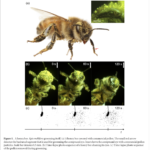Paper, Honey bee hairs and pollenkitt are essential for pollen capture and removal
Pollinating insects, like honey bees, purposely cover themselves with millions of pollen particles that, if left ungroomed, would make sensing and controlled flight difficult. How do they get clean? We show that the hairs on insect eyes are tuned to the pollen they collect; namely, the hairs are spaced so that they suspend pollen above the body for easy removal by the forelegs. In turn, hair spacing on the foreleg dictates the leg’s ability to store the pollen removed during each swipe. In tests with wax-covered honey bees, we show that hairy forelegs are necessary for pollen removal. Moreover, the viscous fluid found on the surface of pollen grains, or pollenkitt, greatly enhances adhesion. We find that bees accumulate twice as much pollen if pollenkitt is present. This study may help further understand pollination, as well as inform designs for mechanically-sensitive functional surfaces with micro- and and David L Hu nano-structures that are easier to keep clean.
Learn about our two Decals!
 Click here to find out more about our Fall Bioinspired Design Decal and our Spring Bioinspired Design in Action Decal – ALL MAJORS are welcome.
Click here to find out more about our Fall Bioinspired Design Decal and our Spring Bioinspired Design in Action Decal – ALL MAJORS are welcome.Berkeley BioDesign Community
 Click here to learn about the BioD: Bio-Inspired Design @ Berkeley student organization or here to signup for more info.
Click here to learn about the BioD: Bio-Inspired Design @ Berkeley student organization or here to signup for more info.Search
Student Login




I imagine that the neurological circuits underlying these processes are governed by both 2d spacing maps with their brains as…
to reduce the impact of car accidents, it may be possible to study the force diverting physics of cockroaches to…
you see this type of head-bobbing stability in many avian creatures related to pigeons like chickens. the head ability to…
not like they taught horses how to run! this is an example of convergent evolution where both sea creatures and…
The brain functions in a similar way with neuronal connections. our brains are able to utilize the multiplicity of connections…